21 Types of Rakes to Handle Any Loose Material or Task
Author: Chris Miller | Editor: Omar Alonso
Review & Research: Jen Worst & Chris Miller
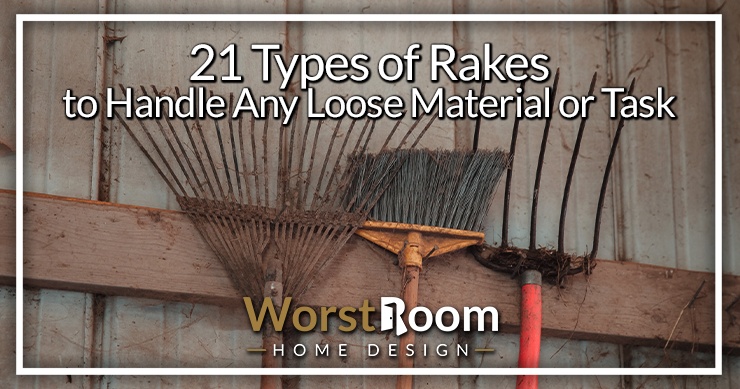
All types of rakes are easily among the common household tools that are used in gardening and clearing as well as for industrial usage in agriculture and landscaping. They are used for gathering leaves, cutting the dead grass, and leaving out the live ones, tidying up the lawn, leveling the ground, etc.
Even though you must know your ways with cleaning and gardening with rakes, we would love to tell you more about the different types of rakes that are available out there for different uses. Let's get going.
21 Types of Rakes
An interesting trivia fact is that the earliest example of a garden rake that can be found in the US patent system comes from 1874, though the Farmer's Almanac mentioned raking in their 1844 edition. But rakes go much further back, with some even discovered in China dating back to 1,100 BC.
The modern rakes are usually made up of plastic, steel, bamboo teeth, or tines with steel, plastic, wood, or fiberglass handles. They come in different shapes, sizes, and flexibility depending on the purpose. Below you will find everything you need to know about different rakes.
Leaf Rake
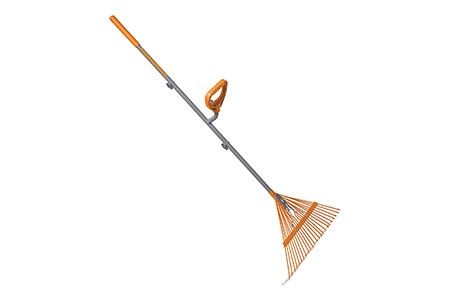
Leaf rakes are constructed in a way to pile up leaves or light objects without damaging the grass or scraping off the soil. It is made up of metal or plastic tines with a slight bend at the end. The fan-shaped or inverted triangle-shaped head is attached to a long handle, making it flexible to use.
It can be made out of different materials such as plastic, bamboo, wood, or steel. Plastic or wood rakes are rust-resistant, lighter, and cheaper than steel or metal ones, while metal or steel rakes are more durable and are easier to use for the heavy or wet pile of leaves.
To prevent the tines from rusting, oil these rake types from time to time.
Lawn Rake
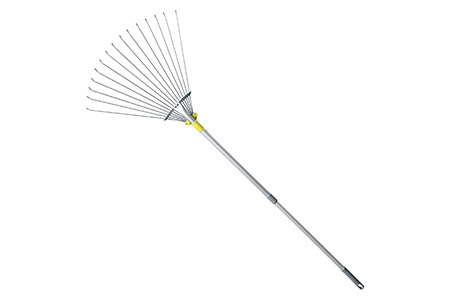
Lawn rakes and leaf rakes do not have many differences in their design and usage. The head is completely made up of long, thin tines spread out in a fan shape – making them flexible to use.
Lawn rake can be used on uneven ground without catching dirt and can lift off many other light objects. They also work on grass surfaces you may want to be more careful with like certain types of Bermuda grass, and you can always drag them along even more lightly if you wish.
Leaf Scoop Rake
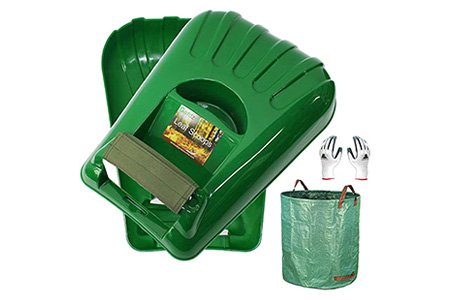
Leaf scoop rakes make the job easier than using a leaf rake. When it comes to leaf rakes, they’re mostly used for gathering the leaves in a pile. You’d have to bend down and manually scoop the leaves into a wheelbarrow or a trash can.
With the help of leaf scoop rakes, you can easily pile the leaves in a specific place without bending down and picking them up. These are different kinds of rakes, and in fact I'd consider them types of shovels but manufacturers don't agree with me.
The handle is attached to a set of moving jaws that are usually made up of plastic. These jaws have got thin tines, which makes it easier to pick up leaves. These are only suitable for leaves only and not for heavy objects.
Shrub Rake
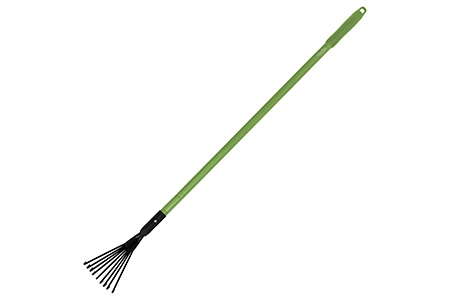
Shrub rakes are similar to leaf rakes, except these are much smaller in size with thin tines smaller than 10 inches. The tines have a similar fan shape to a leaf rake.
These types of rakes are best used in confined places where a leaf rake cannot fit. You can clean up between plants, fences, flower beds, etc. For heavier debris, thick metal tines are preferable.
Garden Rake
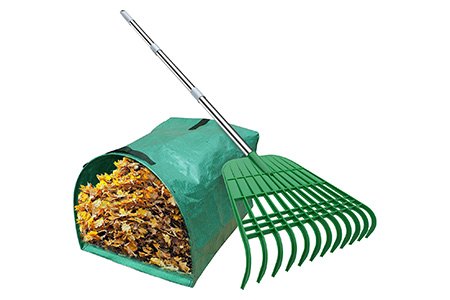
Garden rakes (sometimes called a Dirt Rake) are mostly used by gardeners for making plant rows and loosening, leveling, or breaking up hard clumps of soil. As far as types of garden rakes go, these are made specifically for the task.
Garden rake types are heavier and sturdier than the leaf rakes and is made up of short metal tines that are very firm and do not bend or flex. The tines are spread out and attached to a long straight ahead, and the handles are usually made up of wood.
Hand Rake
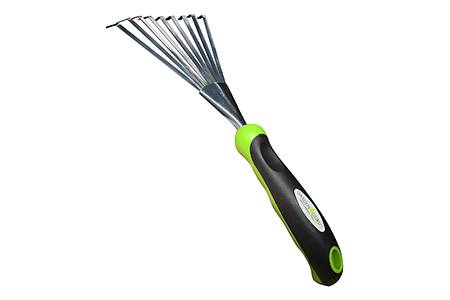
Hand rakes are similarly designed as the garden rakes, except these are much smaller in size. Most rakes can be used while standing; for using hand rakes, the gardener will have to sit down to do the work with much precision.
Hand rakes are not applicable for larger areas; it is used for loosening or breaking up hard clumps of soil in smaller areas.
The head is much smaller. There are sturdy metal tines, attached to a short straight head. The size of the handle is smaller than a garden rake.
Tarmac Rake
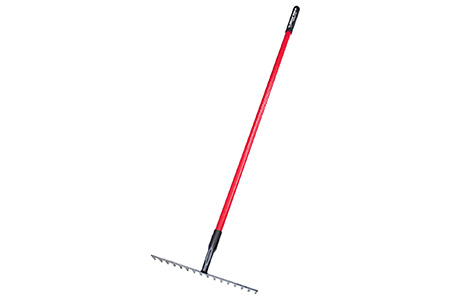
While these kinds of rakes are similar looking to a regular garden rake, tarmac rakes are much stronger and are designed for heavier objects such as rocks and gravels. Sometimes they're called a Stone Rake or a Gravel Rake, as well.
These kinds of rakes have a wider head than a garden rake and is made up of metal with short metal tines attached to it. It can spread out heavy materials like rocks all over the ground without much problem.
Roof Rake
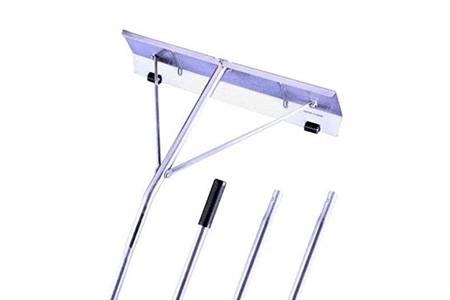
Roof rakes are designed to be lightweight as you will be holding them up. For its lightweight feature, it is made up of light material, such as plastic.
It has a long handle so that it is easy to reach the top without much effort. The long handle ensures that the user is not hurt while cleaning up the roof.
Despite the lightweight, the head is strong enough to pull snow and other objects from the roof to the ground without damaging anything on its way.
Thatch Rake
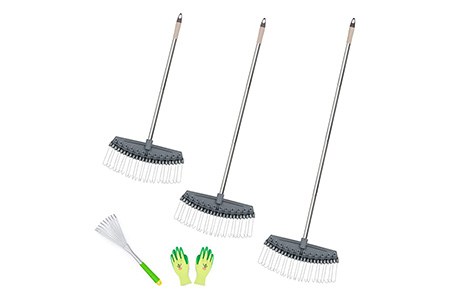
Thatch is a layer of dead stems, roots, crowns, etc., between the soil and vegetation, which has formed with time. Usually, it takes a lot of effort to scrape them off, for which thatch rakes are used to clear them out.
Thatch types of rakes consist of sharp blade-like tines which is strong enough to scrape and pull out the thatch without putting much effort.
Power Rake
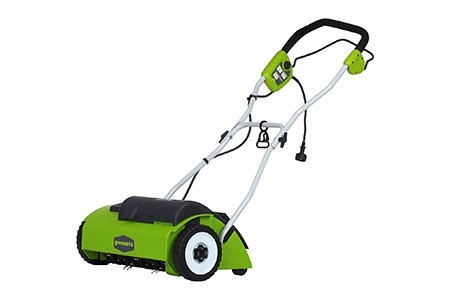
A power rake is essentially an electric or gas-powered thatch rake. These rake types have a cylindrical set of tines that are set to the right depth to dig through the thatch to pull up the dead grass, twigs, and leaves.
Some can be self-propelled and only need you to walk behind them and guide them. Others will require you to push them, but the digging action of the tines are going to help you out by pulling themselves to a degree.
Landscape Rake
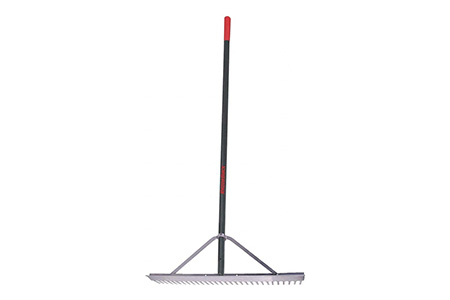
Landscape rakes are not much used by homeowners. This is a kind of rake that is mostly used for industrial purposes as it is faster to complete the job on a larger ground using this.
Even though a landscape rake is mostly used in industrial areas, you can also use it for gardening at home. It is not suitable for raking leaves as the metal tines will scrape the soil.
A landscape rake has this incredibly wide and flat head, perfect for spreading and leveling soil, sand, or any small types of landscaping rocks. You’ll find it handy for mixing compost into the soil, which can improve the soil quality. Since landscape rakes are made of metal, the overall construction they come with is pretty sturdy.
Bow Rake
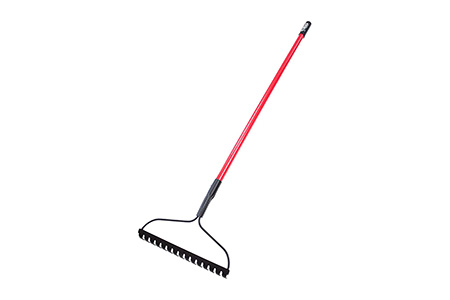
Bow rakes are kind of like landscape rakes but for homeowners. These yard rake types are used for pulling and pushing around materials like dirt, sand, mulch, and mulch alternatives like gravel or rocks.
The tines are made of thick metal and will be extremely durable. I used one of these yard rake types growing up doing yard work in my mom's various types of gardens, whether flower beds or food gardens.
Hay Rake
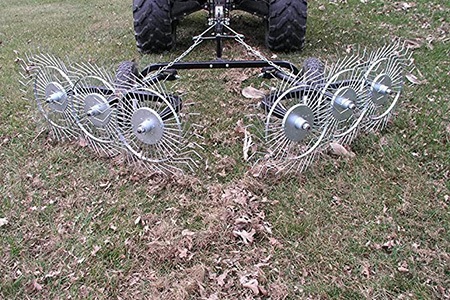
Hay rakes are usually used in farms or ranches to gather hays or dried grass from large areas without putting much effort.
While the hay types of rakes look similar to the landscape rakes, it is not as sturdy as a landscape rake and is not suitable for heavy materials.
Poop-Scoop Rake
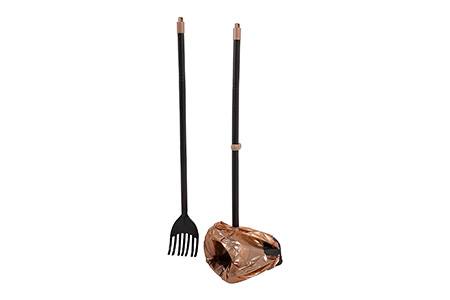
A poop-scoop rake is used by almost every pet owner to scoop off their pet's poop off the ground. It is a set of rake and scoop pans and is used in a similar way as a broom and dustpan.
It has an extendable handle, for which the user will not have to bend down. To make it easy to carry, it is made up of plastic so that it is lightweight.
Lake Rake
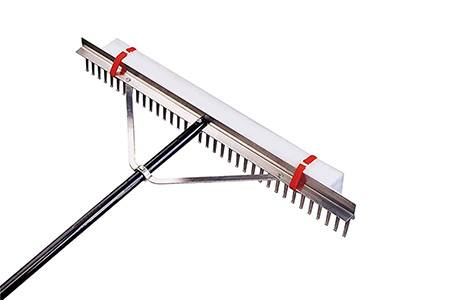
This is a type of rake that is used to clean up ponds, lakes, swimming pools, etc. Lake rakes have two designs making them easier to use.
One type is a flat head attached to a long handle to reach every side with ease, and the other type has a rope attached to its head. The head is designed to remove algae and weeds growing in the water bodies.
Concrete Rake
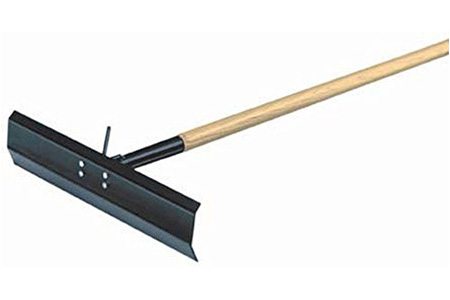
Concrete rakes consist of a head which usually has a textured side as well as a flat side. These kinds of rakes are used for smoothing out wet concrete as well as moving them before it dries.
Berry Rake
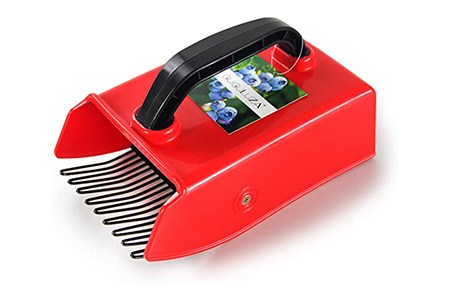
Berry rakes are used for plucking berries from plants through the leaves without actually going near them. It consists of a small head that is shaped like a container to gather the berries inside it.
Fire Rake
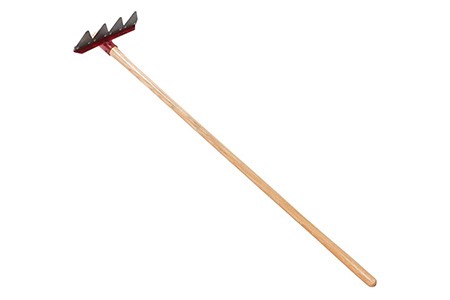
Fire rakes are used by firefighters. Thanks to the strong triangular fireproof tines they come with, you can push dirt back toward the fire to stop it from spreading.
It is used to keep the fire away from an already burnt place. There’s a handle long enough to keep a safe distance from the flame but short enough to manage easily.
Ash Rake
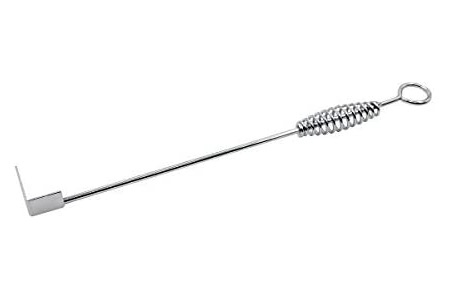
Ash rakes are used to clean grills or fireplaces without getting burnt. These types of rakes are completely made up of metal with a small flathead to scoop out the ash and a short rod-like handle.
Zen Garden Rake
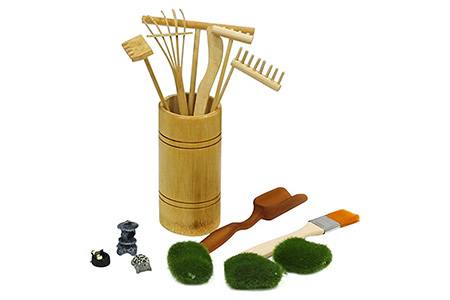
This one has been used for meditating and small decorations. A zen garden is a setting with precisely clipped shrubs and controlled, raked sand around rocks. Zen garden rake types can be used to carefully move the sand around rocks as well as create patterns on the sand.
Child’s Rake
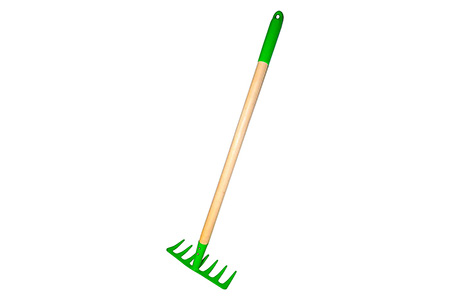
Child’s rakes are for children to use if they are interested in helping you with yard work. It is designed in their size, making it safer and easier for them to use. Rather than struggling with rakes taller than them, they can use this to clean up leaves from your yard.
Types of Rakes for Every Task & Chore
Now that you are familiar with the different types of rakes available out there, we hope you are able to make ideal uses of each type if not at least find the one you need for the task at hand.



